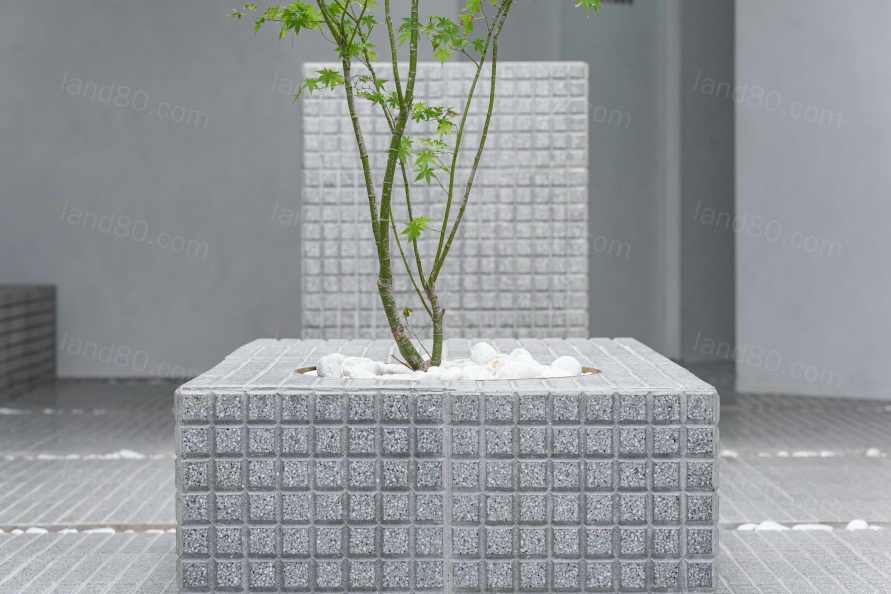该项目被设计成一个极简的空间,具有快速感知的简单线条,纯粹的几何形状与中性色调、石头材料、特定的植被相协调,以及一个中央雕塑作品作为主要照明元素。项目致敬了布宜诺斯艾利斯的广场,在那里,东西方文化的一些元素与咖啡的香气融合在一起。
The project was designed as a single space with quickly perceived simple lines, with pure geometries in harmony with neutral tones, stone materials, specific vegetation, and a central sculptural piece as the main lighting element. It was developed alluding to the squares of Buenos Aires, where some elements of the national and eastern culture merge with the aroma of coffee.

场地必须被赋予一定的多功能性,以便能够适应未来的情况和用途,而这些情况和用途可能在一开始是没有预料到的。设计师的建议是创造一个和谐和简单的空间,在这里可以进行不同的使用和功能。JISU产生于创造一个与动态空间有关的品牌的想法,在这里,用途和美食提供,以及公众和它的范围,可以随着时间的推移而改变,产生一个多功能的空间。
The site had to be endowed with a certain versatility to be able to accommodate future situations and uses that might not have been considered from the beginning. The proposal was to create a harmonious and simple space, where different uses and functions can be carried out. JISU arises from the idea of creating a brand in relation to a dynamic space, where the uses and the gastronomic offer, as well as the public and its scope, can be transformed over time, generating a multidisciplinary space, always accompanied by a rich specialty coffee.

项目是一个休闲的空间,它是一个慢下来空间。它是一个不假思索地给出答案的空间,不假思索地给游客提供条件,从而允许沉思和休闲释放想象力,培养个人的创造力。为了实现对布宜诺斯艾利斯市中心公共空间的回忆,我们决定使用该市所有广场和人行道上最常见的瓷砖之一:64面瓷砖。通过这种方式,参观者可以在潜意识中把在这层楼上行走时产生的感觉与在城市露天公共空间发生的经历联系起来。
JISU is a space for recreation, it is a moment to slow down, it is an instant in which time stops. It is a space that does not pretend to give answers, that does not pretend to condition the visitor, thus allowing contemplation and leisure, freeing the imagination, and fostering the creativity of the individual. To achieve the reminiscence of the public spaces of the Buenos Aires centre, a decision to use one of the most seen tiles in all the squares and sidewalks of the city was made: the 64-sided tile. In this way, the visitor could subconsciously relate the sensations generated when walking on this floor to experiences that have taken place in public spaces in the open air of the city.

为了强调广场的特点,没有添加任何家具作为场所内的移动设施。取而代之的是设计了长椅,就像它们在城市的公共空间中所呈现的那样,造成了构造银行、花盆、支持部门和酒吧的外观。这样一来,就会出现一个模块,它将配置和空间上的图示整个项目,即40x40厘米的模块(64片瓷砖的尺寸)。这种模式存在于所有的咖啡馆部门,在构成它的所有元素之间产生了一种关系,寻求一种由几何图案支配的空间和谐,有些是可见的,容易理解的,有些则是比较隐蔽的。
To emphasize the character of the square, no furniture as mobile pieces within the premises were added. Instead, benches were designed, as they are presented in the public spaces of the city, resulting in the appearance of tectonic banks, flowerpots, support sectors, and a bar. In this way, a module would appear that would configure and spatially diagram the entire project, the 40x40 cm module (size of the 64-piece tile). This pattern is present in all cafe sectors, generating a relationship between all the elements that make it up, seeking a spatial harmony governed by geometric patterns, some visible and easy to understand, others more hidden.

在布宜诺斯艾利斯市中心的广场,如五月广场,使用的另一个参考元素是用球形或椭圆形灯具装饰的金灯笼。从这些历史悠久的城市基础设施中,金色的颜色和球形的形状被纳入了项目。球体作为一个纯粹的几何图形被用来设计酒吧的照明,获得了一个简单线条的艺术品,总高度约为三个模块(120厘米),球体的直径为半个模块(20厘米),彼此之间的距离为两个模块(80厘米)。路灯的内置金色,在亚洲文化中也是高度可见的,并迅速与亚洲文化联系起来,是咖啡馆所有细节的首选颜色,如底板、铁匠铺、灯具等等。
Another referential element used in the central Buenos Aires squares, such as Plaza de Mayo, are the golden lanterns decorated with spherical or oval lamps. From these pieces of historic urban infrastructure, the golden colour and spheric shape were incorporated into the project. The spheres as a pure geometric figure were used to design the lighting of the bar, obtaining an artefact of simple lines with a total height of approximately three modules (120 cm), with a sphere with a diameter of half a module (20 cm), separated from each other with a distance of two modules (80 cm). The built-in golden colour of the streetlights, which is also highly visible in and quickly linked to Asian cultures, was the colour of choice for all the details of the cafe, such as baseboards, blacksmithing, light fixtures, and more.

该场所的总体空间布局由单体水吧和与之相伴的连续的楼层部门之间的持续联系所支配。每个楼层区域相当于一个宽度为四个模块(160厘米)的条状物,可以想象为以直角折叠的细长平面,从而形成寓言广场中不同类型的长椅和花坛。这些条带中的每一条都反映并补充了酒吧的不同用途。
The general spatial layout of the premises is governed by the constant link between the monolithic bar and the successive floor sectors that accompany it. Each floor sector is equivalent to a strip of a width of four modules (160cm), which could be imagined as elongated planes that fold at right angles, thus forming the different types of benches and flowerbeds in the allegorical square. Each of these strips reflects and complements the different uses of the bar.
总共可以区分出八条连续的地板条垂直于酒吧的主轴,设计成地毯或宽度为四块瓷砖的平面,它们以90°的角度折叠,配置出长椅、支架和花盆的系统。这些条带中的每一条都被一条圆形的白色石头分开。这条带子除了可以区分四个模块(160厘米)的连续面板外,还实现了几个功能。每条沟都是一条四米长的线性水沟,每条沟都与其他沟相连,旨在保证良好的排水和场所的清洁。圆形白色石头的选择在直觉上将我们与亚洲文化联系在一起,但同时,由于土壤物质性的变化,它停止了我们行走的节奏,放慢了平时的速度,使我们观察和沉思周围的环境。
In total eight successive strips of floor can be distinguished, perpendicular to the main axis of the bar, designed like carpets or planes of a width of four tiles, which are folded at 90 ° degrees to configure the system of benches, supports, and flowerpots. Each of these strips is separated, one from another, by a strip of round white stones. This strip fulfills several functions, in addition to allowing distinguishing the successive panels of four modules (160 cm). Each of these furrows is a four-meter linear gutter, each connected to the others, designed to guarantee good drainage and cleanliness of the premises. The selection of the round white stone connects us intuitively with Asian cultures, but at the same time, it stops the rhythm of our walk due to the change in the materiality of the soil, slowing down the speed of the usual routine, making us observe and contemplate the surrounding environment.


中心雕塑艺术品是艺术家保罗森德的作品。空间由建筑师开辟,以促进项目内的多学科工作,鼓励分享和结合知识和学科的想法,展示不同的艺术分支如何在同一空间内和谐相处。
The central sculptural artefact is the work of artist Paul Sende. Space was opened by the architect to promote multidisciplinary work within the project, encouraging the idea of sharing and combining knowledge and disciplines, showing how different branches of art can live in harmony in the same space enriching it.


该艺术品是由12个四分之一圆的模块组成的。这些圆片的直径与地板面板的调制相吻合,与咖啡馆地板的起源模块产生了几何联系。弧形线条的人工制品因其形态构成而脱颖而出,与包含它的空间的直角的刚性形成对比,但同时,它与周围的整体保持着几何关系。
The artefact is made up of twelve concatenated quarter-circle-shaped modules. The diameter of these circular pieces coincides with the modulation of the floor panels, generating a geometric link with the genesis module of the cafe floor. The artefact of curved lines stands out for its morphological composition, contrasting with the rigidity of the right angles of the space that contains it, but at the same time, it maintains a geometric relationship with the surrounding whole.


它的所有模块都经过编程并相互连接,实现了一个静态的照明位置,功率可调,加上总共六个不同的照明序列,形成了一个非常有吸引力的灯光运动,有时设法重现太阳下的云层,把我们带到一个可能的户外体验的情况。
All its modules are programmed and connected to each other, achieving a static lighting position with adjustable power, plus a total of six different lighting sequences, resulting in a very attractive movement of lights, which at times manages to recreate the passage of clouds under the sun, moving us to a possible situation experienced outdoors.
Project name: JISU: Speciality Caffee Shop
Company name: Tomas Mielnikowicz
Website: https://www.tomasmielni.com/
Contact e-mail: tomas.mielni@gmail.com
Project location: Argentina – Buenos Aires – Puerto Madero
Completion Year: 2020
Building area (.0m²): 100.0m²
Other participants: Melko Construcciones, Paul Sende @paulSende, Monolitic.arq @monolitic, Quadri @quadribsas, Ana Zayas @zayasanai, Mercedes Risso @archisthetic
Photo credits: Hernan Taboada @ht.ph
|